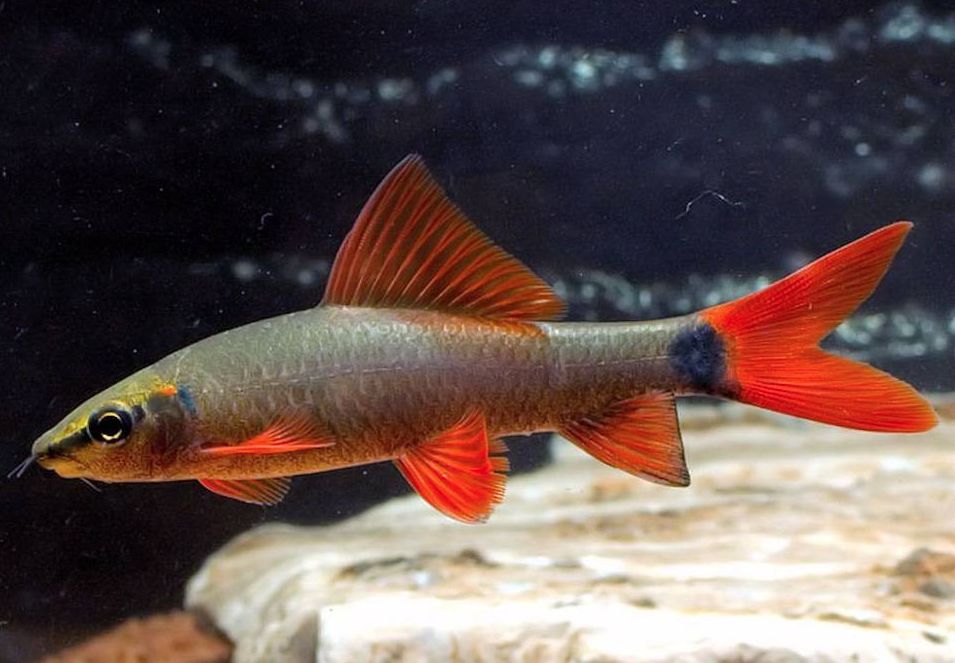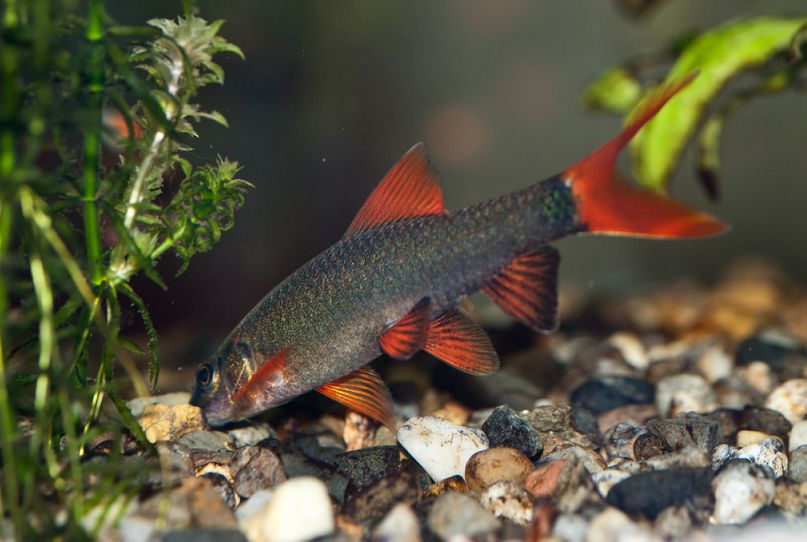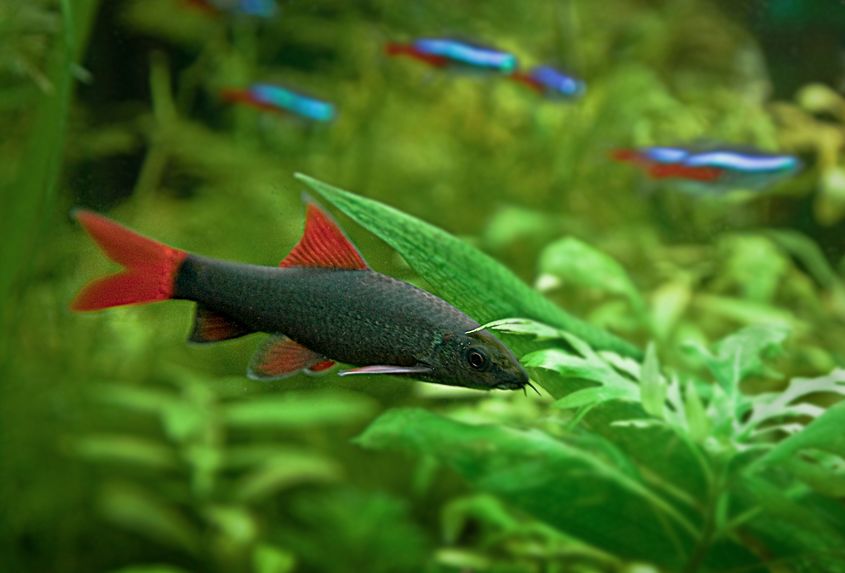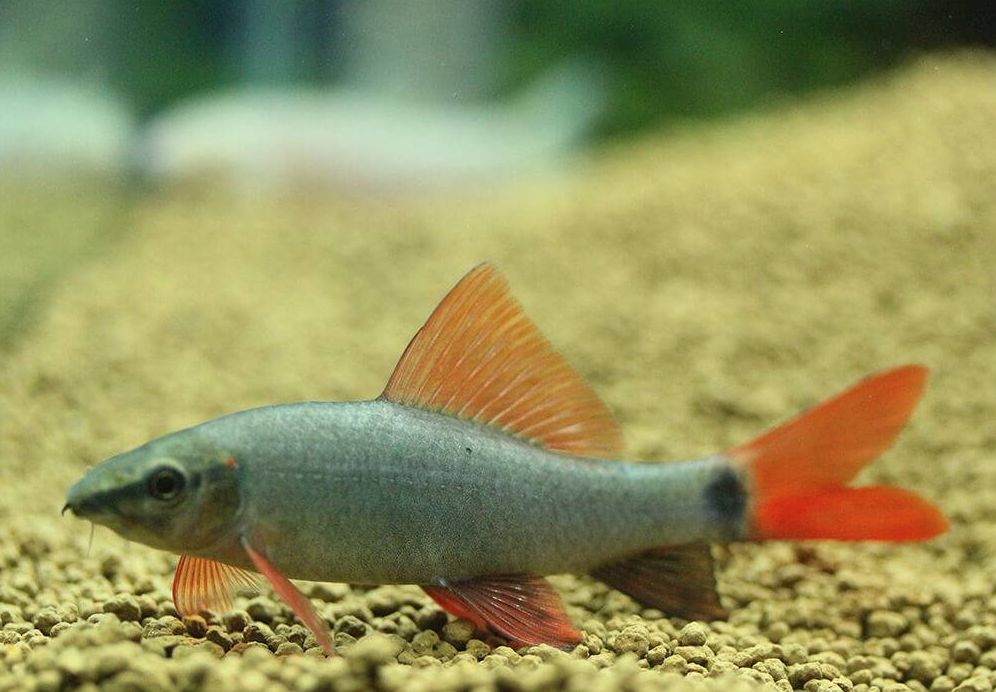Rainbow shark (lat. Epalzeorhynchos frenatus) is as popular as its very close relative – red-tailed black shark. Despite its common name, the rainbow shark is not a true shark but rather a type of freshwater fish. As for their care, behavior and compatibility these fishes are very much alike, though there are some nuances and you will find out about them from our article.

Contents
Habitat in the wild
The rainbow shark, also known as the red-fin shark or ruby shark, is a popular freshwater aquarium fish belonging to the Cyprinidae family. The Cyprinidae family is one of the largest families of freshwater fish and includes a wide variety of species, ranging from small minnows to larger carps and barbs. They are found in various habitats across the world, predominantly in freshwater rivers, streams, and lakes.
In the wild rainbow shark inhabits in the north of Thailand, Nakhon Sawan province, where they are caught in clean warm streams of Chao Phraya river headstreams. According to data provided by different authors, hydro-chemical parameters of water where the rainbow shark was caught vary rather significantly: water hardness is from 3 to 12°, pH 6,5—7,8, This indicates that the fish has high adaptability.
This elongated greenish-gray fish with red fins look like they were born to swim fast. They look very fascinating among tank greenery and stones. Main food for this fish is fouling on snags, stones and plants.
With two pairs of short barbels the rainbow shark probes substrate and scrapes tiny organisms and algae from it. Its mouth is perfectly adapted for this purpose – it is turned downwards, since this is a bottom feeder. The rainbow shark eagerly eats crustaceans, blood worms, small insects that fall into the water, though there isn’t much of such food in clean fast rivers where they live.

Description
Body
It is a bottom feeder that can be seen from its mouth shape. It has two large eyes on its small head, a scraping sucker mouth with two pairs of barbels and ceratoid filaments that cut algae and fouling from surfaces. Rainbow shark body is elongated, flattened from sides with curved spine.
Color
The fish coloring varies from greenish and gray to black, the tail fin is red. Males have red fins and their anal fin has black edges. There is also albinotic type of the rainbow shark.
The albino rainbow shark (Epalzeorhynchos frenatum var. albino) is a color morph of the regular rainbow shark (Epalzeorhynchos frenatum). As the name suggests, the albino rainbow shark lacks the typical pigmentation found in the regular version, and it exhibits a pale, pinkish-white or light orange coloration.
The albino rainbow shark possesses the same general characteristics and behavior as its non-albino counterpart. It is recommended to keep them separately from green ones when they grow – is less competitive when it is young. Further, when the fish becomes adult, you can keep both species together.
Size
In a tank the rainbow shark grows to become up to 6 in (15 cm) large.
Rainbow sharks can grow to a maximum size of around 6 inches (15 centimeters) in length. When these fish are young, they are typically much smaller and may be around 2 to 3 inches in length. As they mature, they gradually reach their full adult size of approximately 6 inches.
Lifespan
Fish is reproductive at the age of 11 — 12 month and its lifespan is about 6 years, but some of them may live much longer.
| Characteristic | Description |
|---|---|
| Scientific Name | Epalzeorhynchos frenatum |
| Common Names | Rainbow Shark, Red Fin Shark, Ruby Shark |
| Family | Cyprinidae (Minnow Family) |
| Origin | Southeast Asia, particularly Thailand |
| Max Size | Around 6 inches (15 cm) |
| Lifespan | 5 to 8 years or more in well-maintained tanks |
| Temperament | Semi-aggressive |
| Tank Size | Minimum 55 gallons (208 liters) recommended |
| Tank Setup | Provide hiding spots and open swimming areas |
| Water Parameters | pH: 6.5 – 7.5, Temperature: 72°F – 79°F (22°C – 26°C) |
| Diet | Omnivorous, feed a mix of high-quality pellets, flakes, and occasional live/frozen foods |
| Behavior | Territorial, can be aggressive towards similar-looking species and fish of the same family |
| Compatibility | Can be kept with compatible species, avoid housing with other aggressive fish or fin-nippers |
| Breeding | Rarely bred in home aquariums |
| Special Considerations | Avoid sharp decorations that could damage its delicate body |
Difficulties in keeping
This rainbow shark is quite difficult in care and it is not recommend for beginners. Except requirement for tank conditions, the fish temper is another issue. The fish is quarrelsome and territory dependent one. You should choose tank mates very carefully, since it may just kill the fish it doesn’t like.
Keeping in a tank
Water parameters
Hydro-chemical properties of tank water are less significant, since fish can successfully adapt to wide range of pH and dH values. These are comfortable tank water parameters for keeping:
- Temperature: 72°F – 79°F (22°C – 26°C)
Rainbow sharks are tropical fish and thrive in water that is within this temperature range. Avoid drastic fluctuations in temperature, as it can stress the fish. - pH Level: 6.5 – 7.5
Rainbow sharks prefer slightly acidic to neutral water. Keeping the pH within this range helps to create a suitable environment for them. - Ammonia (NH3/NH4+): 0 ppm
Ammonia is highly toxic to fish, including rainbow sharks. Ensure that your aquarium is properly cycled, and regularly test the water to maintain ammonia levels at zero. - Nitrite (NO2-): 0 ppm
Like ammonia, nitrites are toxic to fish. A well-established aquarium with beneficial bacteria should effectively convert nitrites to nitrates, keeping nitrite levels at zero. - Nitrate (NO3-): Less than 40 ppm (preferably lower)
Nitrates are less harmful than ammonia and nitrites but can still be problematic at high levels. Regular water changes are essential to keep nitrates under control. - General Hardness (GH): 5 – 12 dGH
Rainbow sharks can adapt to a range of water hardness levels, but a moderate hardness level is generally suitable for their well-being. - Carbonate Hardness (KH): 5 – 12 dKH
The carbonate hardness helps stabilize the pH level in the aquarium. Keeping it within the recommended range contributes to a stable and healthy environment.
It’s essential to use reliable water test kits to monitor these parameters regularly. Just like any fish that inhabits in flowing waters, it requires clean water. Therefore, 20–25% of weekly water renew is a must as well as cleaning of tank substrate with a siphon from organic wastes. It is desirable to use canister filter that will create the flow in the tank resembling the fish natural habitat.
Tank size
Considering fish size and activeness it should have a spacious tank – from 55 gallons (208 liters) of water and more. These fish are active swimmers and can grow to a maximum size of around 6 inches (15 centimeters). Providing them with enough space is crucial for their well-being, especially considering their territorial behavior.
In a larger tank, rainbow sharks will have more room to swim and establish their territories, which can help reduce stress and aggression. Additionally, a larger tank provides more stable water parameters and allows for a more diverse and visually appealing aquarium setup.
If you plan to keep more than one rainbow shark or have other fish in the tank, it’s essential to increase the tank size accordingly. Always ensure that the aquarium is properly cycled, and the water parameters are within the appropriate range for the well-being of your fish. Regular maintenance, water testing, and proper feeding are key to keeping rainbow sharks healthy and happy in their environment.
Substrate
In the wild the fish inhabits in sand cays, therefore the best tank substrate for it is sand. Though, in general, you can use any large grained substrate with smooth edges.
Tank decor
Despite the fact, that this fish is a bottom-dwelling one, it perfectly jumps and does it quite often. So, you should cover the tank.
Some wooden elements provided with good illumination serve a perfect ground for algae to grow – this is additional natural food for the rainbow shark. Tank plants are necessary and important, but keep in mind that rainbow sharks can damage soft leaves and fresh sprouts. Therefore, it’s better to choose tank plants with rough leaves or feed the fish with lots of vegetable food.
Since rainbow shark spends all time on the bottom, it is important that it has enough shelters and quiet places, where it can rest. These can be flower pots, plastic and ceramic tubes, tank plants, snags etc. At that the fish will guard its territory both from other fishes and its relatives.
Diet
In the wild rainbow shark feeds mainly on plant food – fouling, algae. But if you expect it to clean your tank, you are wrong. There are more efficient tank cleaners – otocinclus, bristlenose pleco. In a tank rainbow shark becomes an omnivorous fish. It’ll eat all types of food that falls on the tank bottom. But for healthy living and good coloring the fish diet should consist mainly from plant food.
This may be artificial food for bottom feeders, various vegetables – cucumber, spinach, lettuce. Any type of food will do, as a rule the fish eats food leftovers after feeding its tank mates.

Tank mates
How many rainbow sharks can live together?
This is a semi-aggressive and very territory dependent fish. The rainbow shark juveniles are more or less good-tempered, but as they grow they become more and more territory dependent. That’s why it is important to create as much as possible shelters in the tank.
In general, it is recommended to keep only one rainbow shark per tank to avoid territorial disputes and potential aggression. However, if you have a very large tank (100 gallons or more) with plenty of hiding spots and territories, you may be able to keep a small group of rainbow sharks together. This can sometimes help disperse aggression, but it’s still essential to closely monitor their behavior and have a backup plan if any issues arise.
Rainbow shark will find its place and will guard it even from fishes that are just swimming by. If there is enough space (which means that the tank is quite large), it guarantees you some peace and quiet in it.
But if the fish feels that the tank is crowded, almost all its tank mates will suffer. Therefore, it goes without saying that rainbow shark can’t stand its kind. So, it’s better to have just one fish in the tank, otherwise fights are almost guaranteed.
As for the fish tank mates we can recommend such bottom-dwellers as bristlenose pleco and clown loach. Both are large enough and active, so they won’t let fish hurt them. It’s better to keep fast fishes in middle water layer – like tiger barb, it won’t be disturbed much. Any kind of fish may inhabit in upper water layers, since fish gets there very seldom.
Gender differences: male vs female
Rainbow shark has almost no gender dimorphism. Unlike some other fish species, rainbow sharks do not exhibit significant external sexual dimorphism, meaning there are no distinct visual differences between males and females. Only when the female has eggs you can tell it from a male fish, since it has rounded and fat abdomen. As for albino rainbow shark species, it can be done earlier – the female fish abdomen becomes greenish – these are eggs growing inside her.
However, as rainbow sharks reach sexual maturity, some subtle differences may become noticeable:
- Size: In some cases, females may be slightly larger and rounder than males, but this is not a reliable method of sexing them.
- Coloration: Some fishkeepers believe that females might have a slightly more intense coloration, especially during the breeding season. However, this is not a consistent indicator.
- Behavior: During the breeding season, females may appear plumper as they carry eggs, but this may not always be evident in aquariums. Additionally, males may exhibit more territorial and aggressive behavior during breeding times.
It’s important to note that visual sexing of rainbow sharks is not foolproof, and the differences can be challenging to distinguish, particularly if the fish are not in breeding condition. The most reliable way to determine the sex of rainbow sharks is through internal examination or by observing their behavior during the breeding season, but these methods are typically not practical or recommended for home aquarium owners.
In most cases, unless you have a group of rainbow sharks and observe breeding behavior, determining the sex of these fish accurately may remain uncertain. Fortunately, the care and maintenance of rainbow sharks are generally similar regardless of their sex, so focusing on providing them with an optimal environment and proper care is the best approach.

Breeding
Unfortunately, rainbow shark is still bred only by means of gonadotropic injections. This is due to the fact, that rainbow shark is a river fish and it’s impossible to create conditions similar to those in a stream, including hydrological seasonal changes.
As it was mentioned above, rainbow shark can’t stand its kind. So, to keep a couple of fish you’ll need a very roomy tank, which is a problem for an amateur aquarist. This is the first reason why breeding in a tank at home is very seldom the case. Another reason is, that it’s difficult to see between the male and female fish and to keep a school of fish is possible only in a spacious tank.
And the last obstacle is, that for successful spawning in a tank the rainbow shark requires stimulation with gonadotropic hormones. Summarizing the above, we must say that breeding in a home aquarium is almost unreal thing. The species you see on sale were bred either in South-East Asia fish farms or caught in the wild.